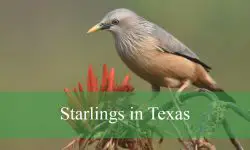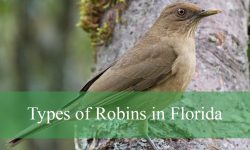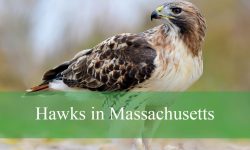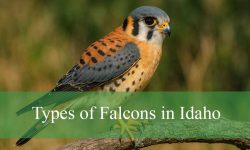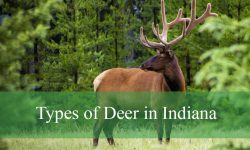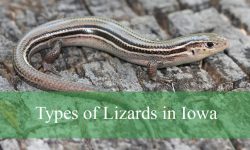New Jersey is home to many small birds that can be seen in parks, forests, backyards, and wetlands. These birds bring color and song to every corner of the state, from city gardens to quiet woodlands. Watching and identifying small birds in New Jersey is a relaxing and enjoyable outdoor activity.
This guide highlights 36 small birds in New Jersey, complete with pictures and useful identification tips. Each species is described by its size, colors, sounds, and habits to help you recognize them easily in the wild or near your home.
Small birds such as finches, warblers, wrens, and sparrows are often seen visiting feeders or singing from tree branches. With this list, spotting these tiny birds becomes easier and more rewarding across the seasons.
Common Small Birds Found in New Jersey
Chipping Sparrow
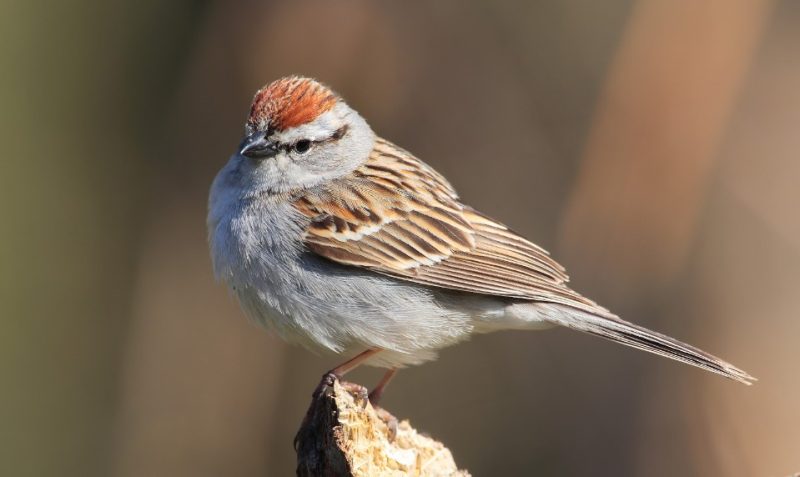
The Chipping Sparrow is a small, slender bird with a distinctive rusty-red cap, gray underparts, and a clean black eye line. It measures about 12 to 15 centimeters in length and has a slim tail that helps with identification. Its overall neat appearance and lively movements make it easy to spot among trees and bushes.
In New Jersey, this sparrow is most common during the spring and summer months. It prefers open woods, suburban parks, and backyard gardens where it often forages on the ground or in low shrubs. The bird’s sharp “chip…, chip…” calls are one of the classic sounds of summer in the region.
Their diet mainly consists of seeds and insects, with insects becoming more important during breeding season to feed their young. Chipping Sparrows frequently visit bird feeders with millet or sunflower seeds. They are widespread breeders in New Jersey and migrate south during winter, although some may remain in the milder southern parts.
White-throated Sparrow
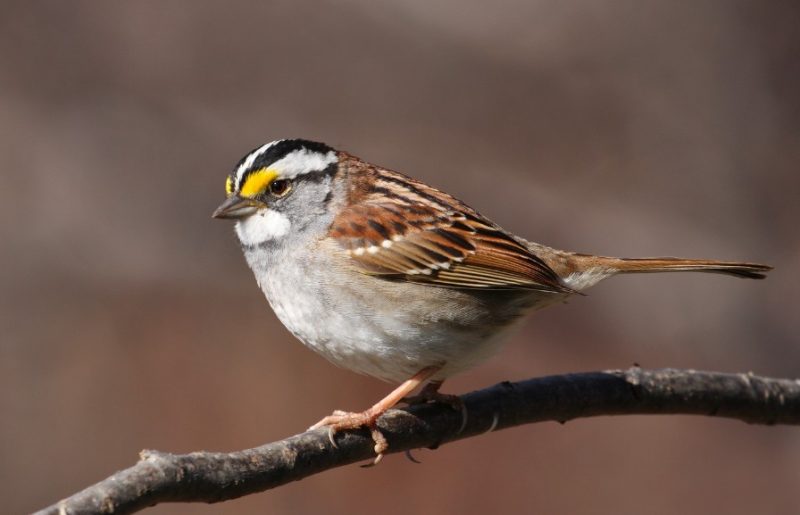
The White-throated Sparrow features a striking white throat patch and bright yellow lores in front of the eyes, along with black-and-white or tan stripes on its head. It is plump and measures about 14 to 19 centimeters long, with a long tail and grayish breast and flanks. These bold facial markings make it recognizable even at a distance.
This species is mostly seen in New Jersey during the fall, winter, and early spring months. It prefers forest edges, dense underbrush, and thick backyard shrubs where it forages on the ground, often in small flocks. Its melodic whistle, often remembered as “Oh-sweet-Canada-Canada,” is especially associated with northern breeding grounds but can be heard during migration too.
White-throated Sparrows eat seeds, fruits, and insects, and they are attracted to bird feeders offering millet or cracked corn. Although their breeding range is further north, many migrate through or winter in New Jersey’s woodlands. Birdwatchers appreciate their bold markings and soft calls in quieter forested areas.
Eastern Towhee
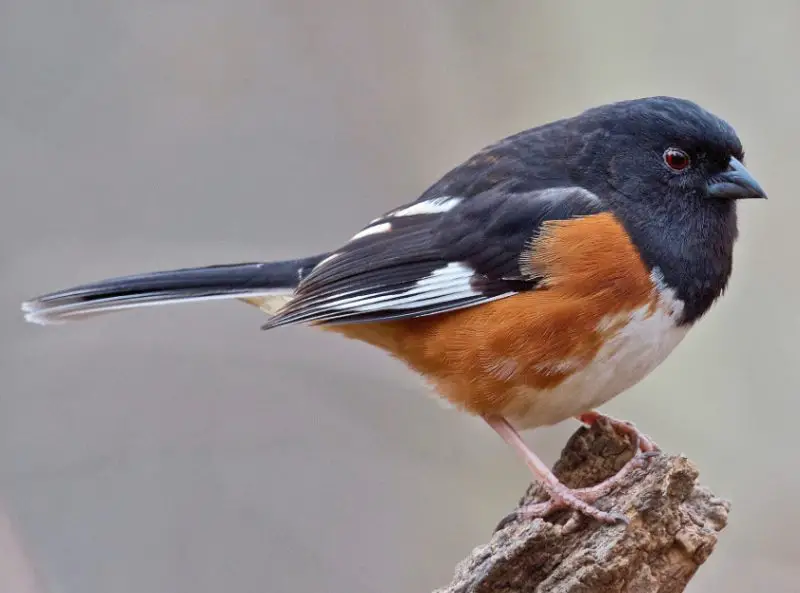
The Eastern Towhee is notable for its bold coloration: males have black upperparts, a white belly, and rich reddish-brown flanks, while females show more brownish tones. It measures 17 to 21 centimeters long and has a thick bill and a long tail with white edges, which is often fanned out during movement.
In New Jersey, Eastern Towhees are common from April through November. They favor dense thickets, forest edges, and overgrown fields where they forage by scratching backward in leaf litter with both feet. Their loud “chewink” call and a clear “drink-your-tea” song during breeding season make them easy to hear even if not seen.
Their diet includes insects, berries, and seeds, which allows them to thrive in a range of habitats. While they migrate south for winter, some may stay in southern New Jersey when food is available. Their bright colors and noisy rustling behavior often reveal their presence before the bird is spotted.
Vesper Sparrow
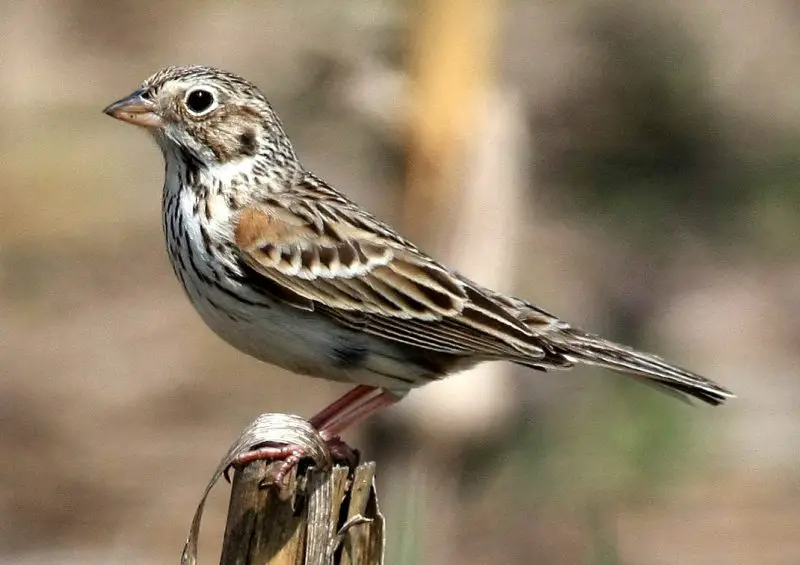
The Vesper Sparrow is a modestly colored bird with a streaked brown back, pale belly, and a distinctive white outer tail feather that flashes in flight. It is about 15 to 17 centimeters long and has subtle features like a faint eye ring and a small chestnut patch on the shoulder.
This sparrow is mainly observed in New Jersey during migration seasons in spring and fall. It prefers dry, open grasslands, pastures, and fields with sparse tree cover. Its song is a beautiful series of clear, descending musical phrases often sung at dusk, giving it the name “vesper,” meaning evening.
Vesper Sparrows primarily feed on grass seeds and insects and are ground foragers that often walk instead of hopping. Though they breed farther north and in the Midwest, New Jersey is an important stopover during migration. Spotting one requires patience and careful searching of open habitats during the right season.
Black-capped Chickadee
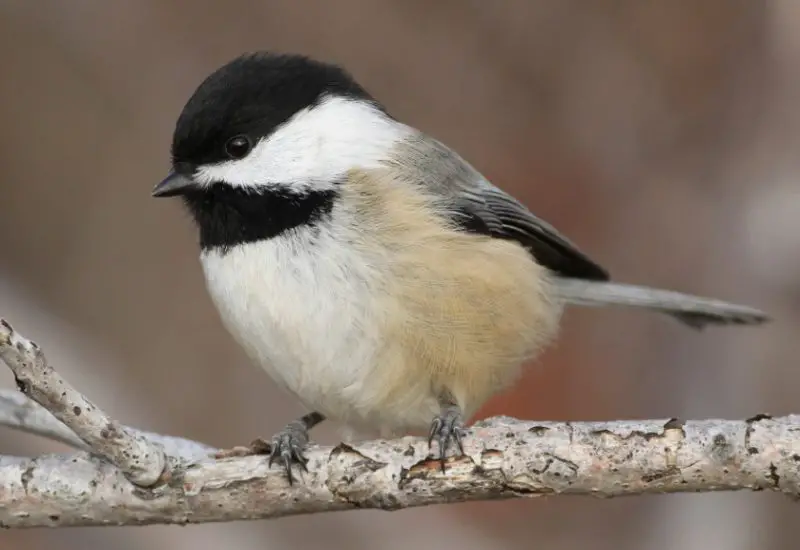
The Black-capped Chickadee is a small, plump bird measuring around 13 centimeters in length. It is easily recognizable by its black cap and bib contrasted with bright white cheeks, giving it a striking facial pattern. Its body is soft gray on the back with lighter underparts.
In New Jersey, this bird is a common year-round resident, often found in deciduous and mixed forests, parks, and suburban areas. It is known for its curious and friendly behavior, frequently visiting bird feeders. Its signature call sounds like “chick-a-dee-dee-dee,” which varies in intensity and number of “dee” notes depending on the situation.
Black-capped Chickadees primarily feed on insects, seeds, and berries. They especially enjoy sunflower seeds at feeders and are expert at hanging upside down to forage on tree branches. Their adaptability and distinctive calls make them a favorite among birdwatchers throughout the state.
Tufted Titmouse
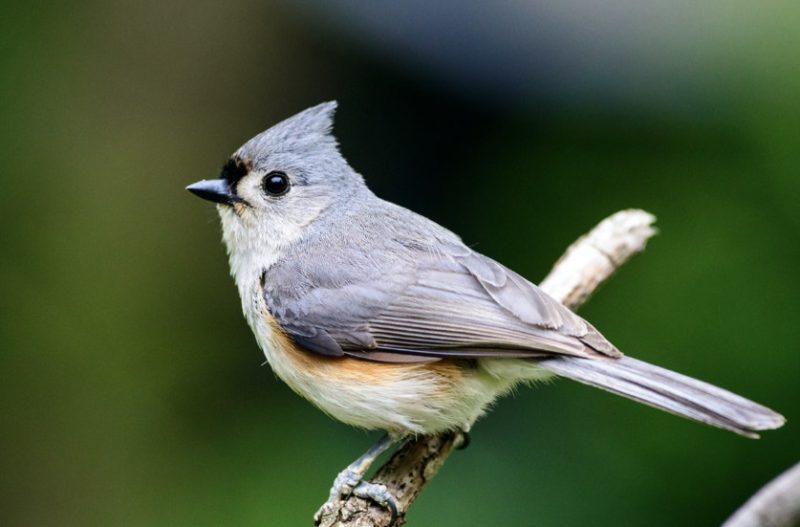
The Tufted Titmouse is a medium-sized songbird measuring between 14 to 16 centimeters long. It has soft gray plumage, a small but noticeable crest on its head, and a white face with subtle black markings around the forehead and eyes. Its rounded body and expressive crest give it a distinctive appearance.
This species favors habitats with dense shrubs and thorny plants and is often seen in deciduous woodlands and suburban gardens across New Jersey. It is active and inquisitive, commonly visiting feeders where it shows a particular fondness for sunflower seeds. The Tufted Titmouse’s calls include clear, whistled notes often described as “peter-peter-peter.”
Tufted Titmice feed on insects, seeds, nuts, and berries. They are known to store food in tree crevices to eat later, demonstrating impressive memory skills. Their presence adds lively activity to backyards and wooded areas during all seasons in New Jersey.
House Sparrow
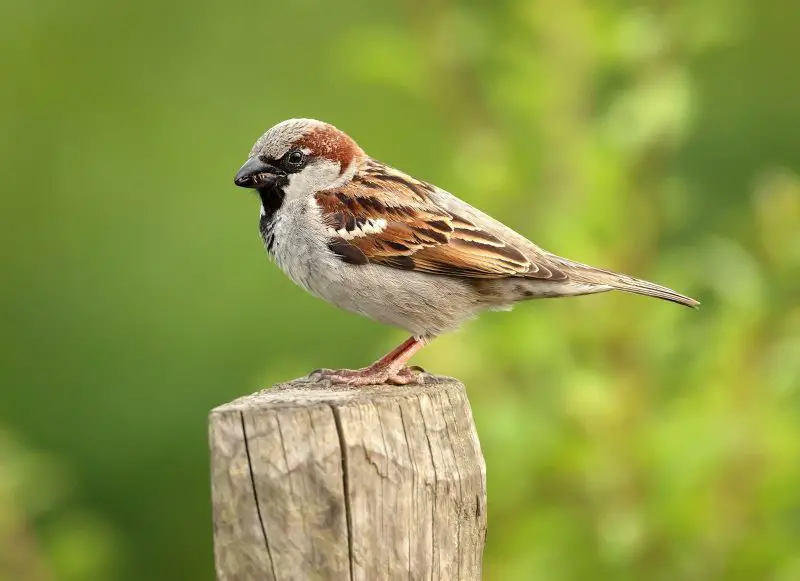
The House Sparrow is a small, stout bird about 15 centimeters long with a grayish-brown body and streaked back. It is an invasive species introduced to North America and has successfully adapted to urban and suburban environments across New Jersey. Males typically have a distinctive black bib and gray crown, while females are more uniformly brown.
House Sparrows are common year-round residents, often seen around human settlements, parks, and farms. They are highly social, forming large flocks especially outside of breeding season. Their chirping calls and constant activity around feeders and nesting sites make them very noticeable.
Their diet consists mainly of seeds, grains, and scraps from human food, though they will also eat insects. House Sparrows are opportunistic feeders and often compete with native birds for food and nesting spaces, which has made them a focus of concern among conservationists in New Jersey.
Dark-eyed Junco
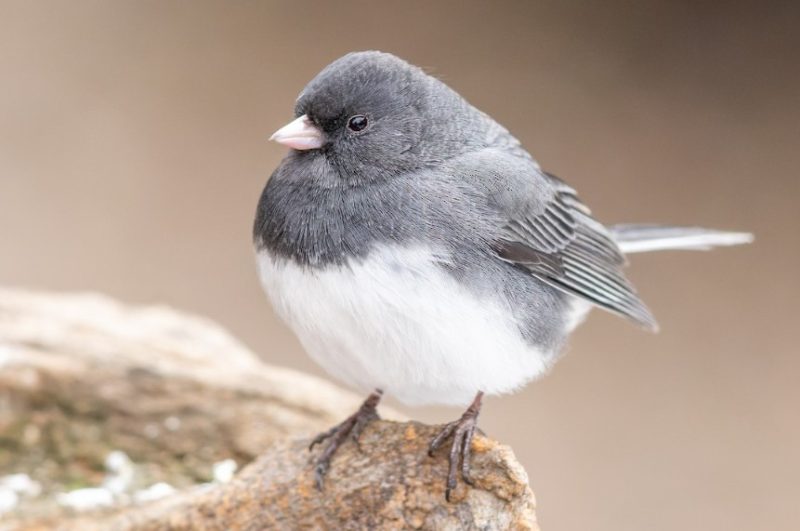
The Dark-eyed Junco is a medium-sized sparrow measuring 14 to 16 centimeters long, easily identified by its charcoal-gray upperparts and bright white belly. Its clean, contrasting colors make it stand out in the winter landscape. This bird is present throughout New Jersey year-round but is most visible during colder months.
They inhabit forests, woodland edges, and backyard feeders, often foraging on the ground in flocks. Their soft “tsip” calls and quick movements as they hop around searching for seeds are characteristic. Juncos are generally shy but become regular visitors at bird feeders during winter.
Their diet mainly includes seeds and insects, shifting toward seeds in winter. Dark-eyed Juncos play an important role in New Jersey’s bird community by helping control insect populations and spreading seeds, making them a welcome sight for many bird enthusiasts.
Carolina Wren
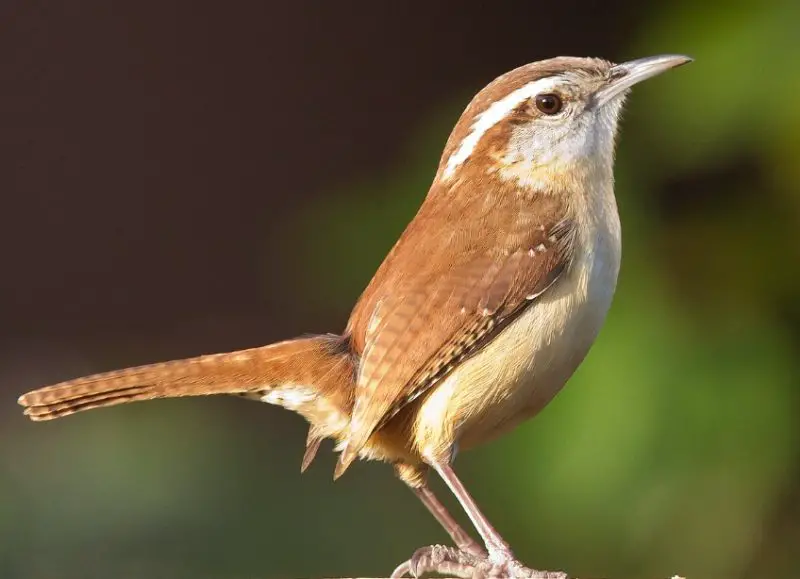
The Carolina Wren is a small, lively bird about 12 to 16 centimeters long, with warm reddish-brown plumage and a prominent white stripe over each eye. It is a common backyard visitor in New Jersey, especially in gardens and wooded suburban areas, known for its loud, clear song despite its small size.
This species is active year-round and prefers dense shrubs, thickets, and brush piles where it builds nests in cavities or protected spots. Its repetitive and ringing song, often described as “teakettle-teakettle-teakettle,” is one of the most recognizable bird calls in the state.
Carolina Wrens feed mostly on insects and spiders but will also eat seeds and fruits occasionally. Their bold, curious nature often brings them close to people, making them a favorite for backyard birdwatchers who enjoy hearing their cheerful calls.
House Wren
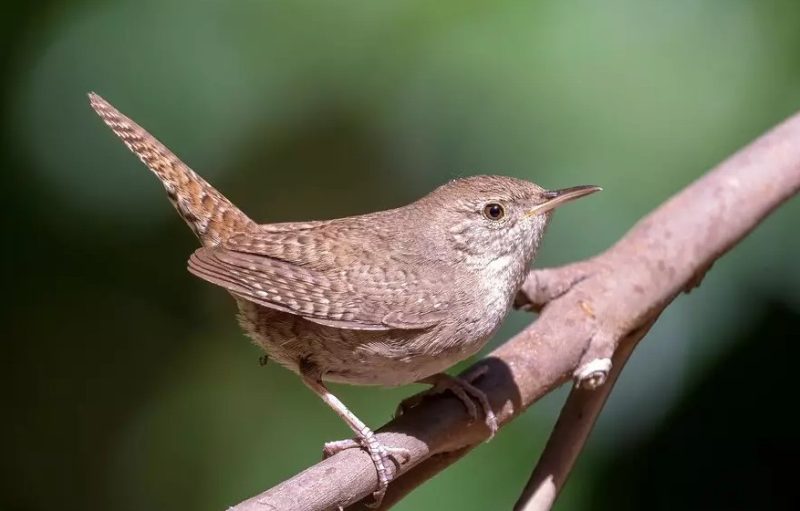
The House Wren is a small bird measuring 10 to 13 centimeters, with a plain brownish-gray plumage and a short, upright tail. It is one of the most widespread wrens in New Jersey, frequenting woodland edges, gardens, and suburban areas. Its small size and relatively plain coloring make it easy to overlook.
House Wrens are very vocal, known for their bubbly and complex songs composed of rapid trills and rattles. They often nest in cavities, birdhouses, or other sheltered spots, fiercely defending their territories with persistent singing.
Their diet mainly consists of insects and spiders, which they skillfully hunt among leaves and branches. House Wrens are beneficial for gardeners as they help control insect pests, and their cheerful presence brightens many New Jersey yards during the breeding season.
Yellow Warbler
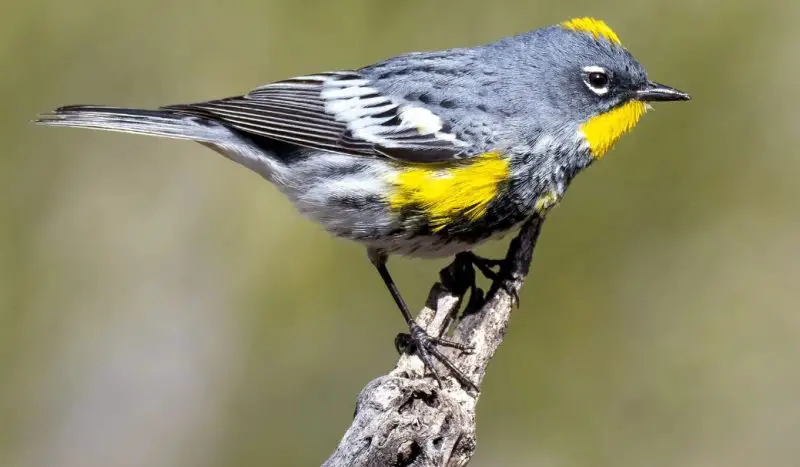
The Yellow Warbler is a small, brightly colored bird measuring 11 to 14 centimeters in length. It is uniformly yellow, sometimes with subtle rusty streaks on the chest, which helps it stand out among foliage. Its vivid plumage makes it one of the most easily recognizable warblers in New Jersey.
This species is most often heard before it is seen, with its sweet, clear “sweet sweet sweet” song ringing through thickets and wetlands during spring and summer. Yellow Warblers prefer habitats near water such as marshes, wet woodlands, and riparian areas where they actively forage among shrubs and small trees.
Their diet consists mainly of insects, especially caterpillars and other larvae, which they pick from leaves and twigs. Yellow Warblers are migratory, arriving in New Jersey in spring to breed before heading south for the winter months.
Palm Warbler

The Palm Warbler is a small, active bird about 11 to 13 centimeters long, best known for its habit of constantly wagging or bobbing its tail. Its brownish-olive back and yellow underparts help it blend in well with grasslands and open areas.
In New Jersey, Palm Warblers are mostly seen during migration, often in open fields, wetlands, and shrubby edges. Their sharp, high-pitched call and restless movement make them noticeable despite their modest coloring. They often forage on the ground or low vegetation, flicking their tail up and down as they search.
They eat insects, spiders, and some berries, making them adaptable to a variety of environments during migration. Palm Warblers are an early migrant in spring and a late migrant in fall, often one of the last warblers seen before winter arrives.
Yellow-rumped Warbler
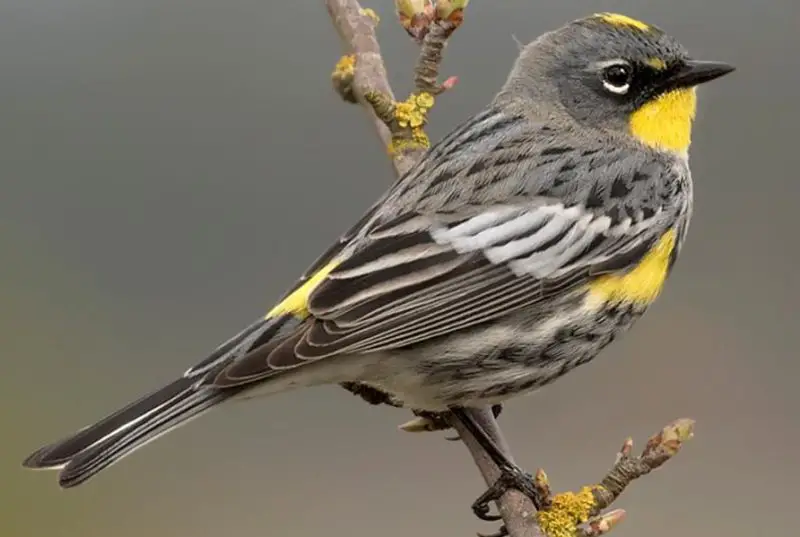
The Yellow-rumped Warbler is a medium-sized warbler distinguished by a bright yellow patch on its rump and sides, with grayish upperparts and streaked underparts. It measures around 13 to 15 centimeters and is one of the most common warblers in New Jersey, especially during winter.
Unlike many warblers, this species is hardy enough to spend the winter months in colder regions. In New Jersey, they frequent a variety of habitats including coniferous forests, mixed woods, and backyard feeders. Their buzzy, trilled song and sharp call notes are often heard throughout the colder season.
Yellow-rumped Warblers eat insects in summer but shift to berries and fruits during winter, especially wax myrtle and bayberry. Their ability to digest waxy berries allows them to survive in colder climates when insects are scarce.
Cape May Warbler
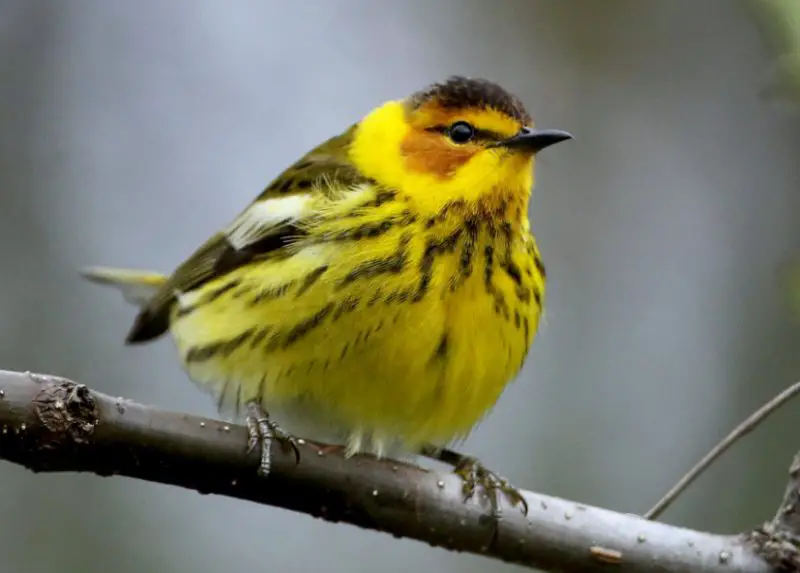
The Cape May Warbler is a slender warbler about 11 to 13 centimeters long, notable for its striking yellow-orange plumage with streaks and a distinctive dark face pattern. It appears in New Jersey primarily during migration seasons in spring and fall.
This warbler prefers boreal forest habitats in its breeding range but can be found in shrubby fields and mixed woodlands while passing through New Jersey. Its high-pitched, thin song and soft calls can be subtle, requiring careful listening to detect.
Diet consists mainly of insects, especially spruce budworms during breeding season, and nectar or berries during migration. Cape May Warblers are considered a special sighting for birders in New Jersey due to their striking appearance and limited presence.
Blue-winged Warbler
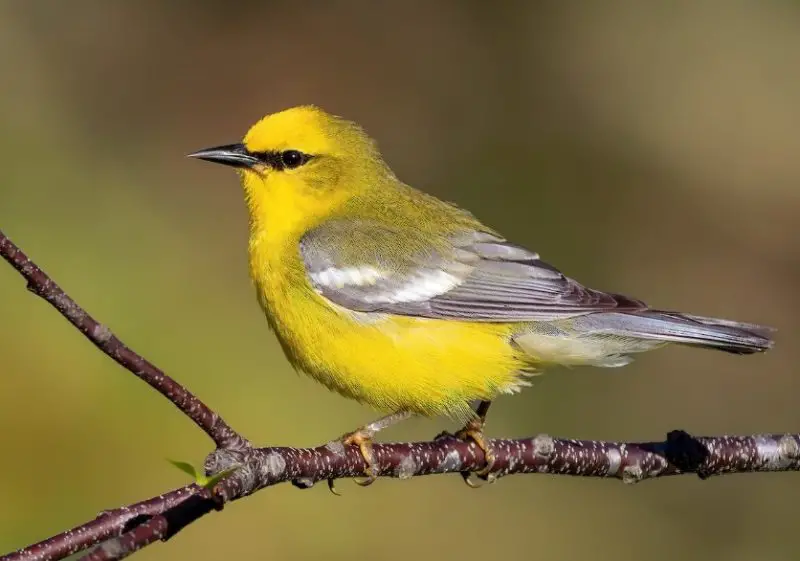
The Blue-winged Warbler is a small, vibrant bird with bright yellow underparts and pale grayish-blue wings and tail. Measuring about 11 to 13 centimeters, it is easy to identify by its combination of yellow body and blueish wings, a unique feature among warblers in New Jersey.
This species inhabits shrubby areas, young forests, and open woodlands, often near edges where it forages actively. Its song is a buzzy, two-part whistle sometimes described as “bee-buzz,” which carries well through dense vegetation.
Blue-winged Warblers feed mostly on insects and spiders, gleaned from leaves and branches. They migrate through New Jersey during spring and fall, with some individuals staying to breed in the warmer parts of the state during summer.
Golden-winged Warbler
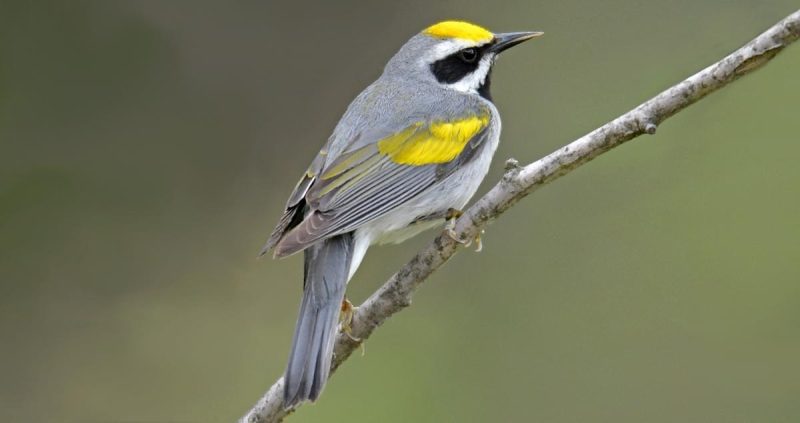
The Golden-winged Warbler is a small, striking bird measuring about 11 to 12 centimeters in length. It is easily identified by its bright yellow crown and wing patches contrasted with a bold black throat and neck band. Its grayish body provides a subtle backdrop for these vivid markings, making it distinctive among New Jersey warblers.
This species prefers young forests, shrubby fields, and regenerating woodlands during the breeding season. In New Jersey, it is primarily seen during migration, passing through in spring and fall. The Golden-winged Warbler’s song is a buzzy “bee-buzz” followed by a clear trill, often heard in dense vegetation.
Their diet mainly consists of insects and spiders, which they skillfully glean from leaves and branches. Conservation efforts are ongoing in parts of their range due to habitat loss, making sightings in New Jersey particularly special for bird enthusiasts.
Northern Parula

The Northern Parula is a petite warbler around 11 to 12 centimeters long, featuring a bluish-gray back and wings with a bright yellow throat and chest accented by a distinct rusty breast patch. Its small size and vibrant colors make it one of the more colorful warblers in New Jersey.
This species frequents mature forests, especially those with abundant moss and lichens where it often nests. In New Jersey, Northern Parulas are seen mostly during migration and sometimes as breeding visitors in suitable habitats. Their song is a rapid series of buzzy notes that sound like “zeee-zee-zee-zee.”
Northern Parulas primarily feed on insects and spiders, foraging actively in tree canopies. They play a valuable role in controlling forest insect populations and add bursts of color and song to the state’s spring and summer birdlife.
Hooded Warbler

The Hooded Warbler is about 13 centimeters long, with males displaying a bright yellow face framed by a striking black hood covering the head and throat. Females and juveniles are more olive-toned with less defined facial markings. This sharp contrast makes the male Hooded Warbler unmistakable in New Jersey’s woodlands.
They prefer dense understory in deciduous forests, often near water. In New Jersey, Hooded Warblers are most commonly seen during the breeding season and migration. Their clear, ringing song—a repeated “hoo-dee-hoo” or “hoodie”—is frequently heard but they can be secretive and well-hidden in thick brush.
Their diet mainly consists of insects and spiders, which they hunt among low branches and leaves. Hooded Warblers contribute to the biodiversity of New Jersey’s forests and are a rewarding sight for birdwatchers due to their vivid coloration and unique vocalizations.
Nashville Warbler
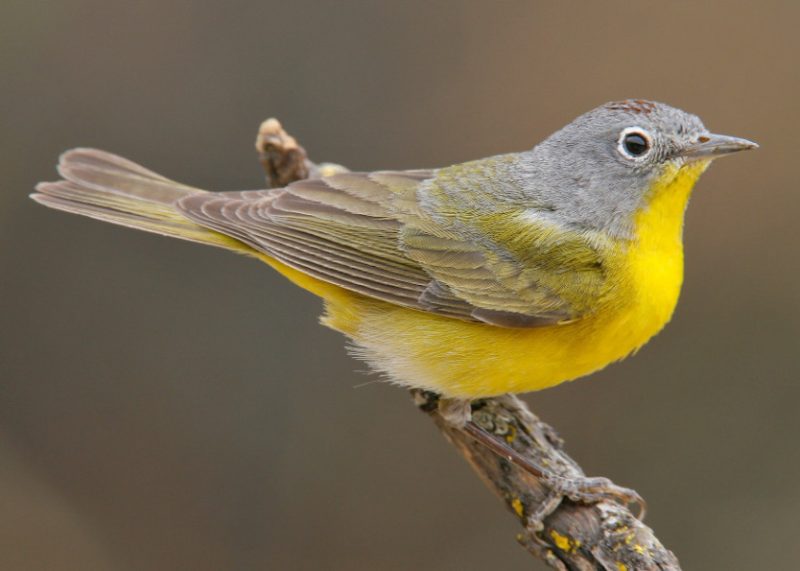
The Nashville Warbler is a small bird measuring 11 to 13 centimeters, characterized by olive-green upperparts and a bright yellow throat and chest. It has a distinctive white eye ring and a relatively plain face compared to other warblers. This subtle yet colorful warbler is mostly seen in New Jersey during migration.
They prefer shrubby areas, young forests, and woodland edges where they forage actively for insects. Nashville Warblers migrate through New Jersey in spring and fall, sometimes stopping briefly to feed before continuing their journey.
Their song is a rapid series of clear notes that rise and fall melodically. Their insect-based diet helps control pest populations, and although they do not breed widely in New Jersey, their seasonal visits add diversity to the state’s warbler species list.
White-eyed Vireo
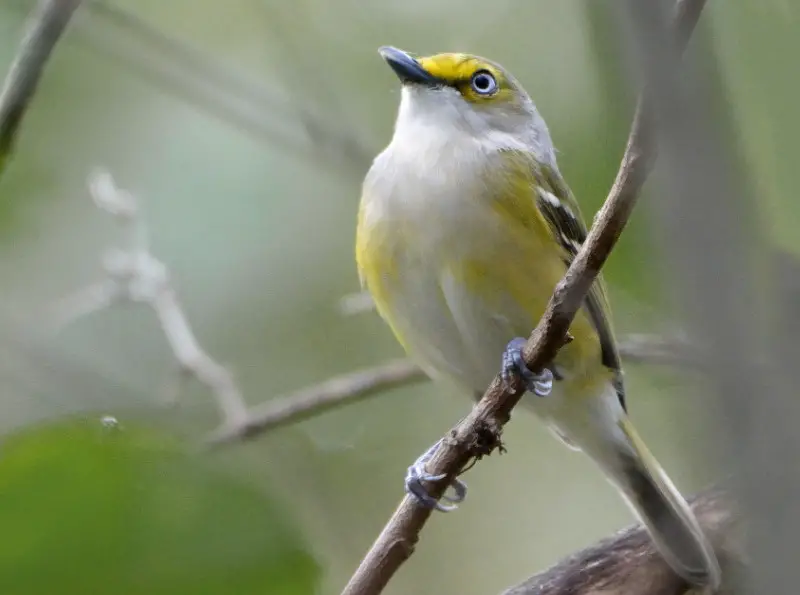
The White-eyed Vireo is a small songbird measuring 11 to 13 centimeters long, easily recognized by its striking white eye ring that contrasts with olive-green upperparts and pale underparts. Its bright eyes stand out sharply, giving the bird its name and helping birders identify it in dense foliage.
In New Jersey, White-eyed Vireos prefer thick brushy habitats, woodland edges, and shrubby thickets, where they actively forage for insects. They are most often heard before seen, as their loud, buzzy call carries through the dense vegetation, making them a favorite among birdwatchers who listen carefully.
Their diet consists mainly of insects and spiders, which they glean from leaves and twigs. Though they migrate through New Jersey, they can sometimes be found during the breeding season in suitable habitats, contributing to the state’s rich diversity of insect-eating songbirds.
Blue-gray Gnatcatcher
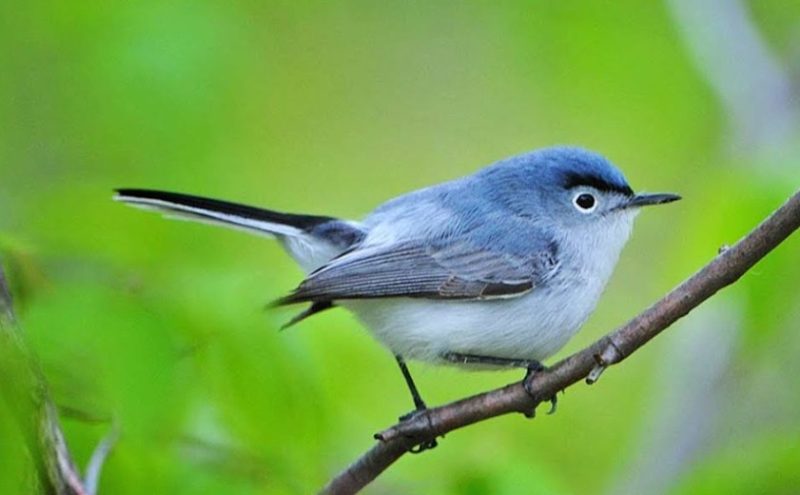
The Blue-gray Gnatcatcher is a tiny, agile bird measuring about 10 to 13 centimeters with soft blue-gray plumage and a long, slender tail often flicked upward. Its small size and subtle coloring make it a delicate presence in New Jersey’s woodlands and shrubby areas.
This bird’s distinctive “pzzzzz” call is a common sound in spring and summer as it busily hunts for insects, especially tiny gnats and spiders. Blue-gray Gnatcatchers are usually found in deciduous forests, edges, and gardens where they flit rapidly among branches.
Their diet consists almost entirely of insects, which they catch on the wing or pick from leaves. They migrate through New Jersey in spring and fall, with some remaining to breed, making them a charming and lively part of the local bird community.
American Redstart
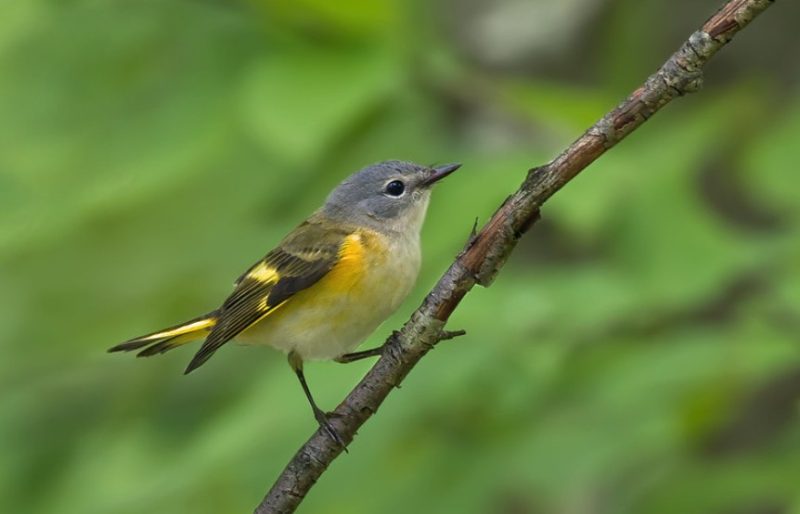
The American Redstart is a small, vibrant warbler about 12 centimeters long, with striking black and bright orange patches on the male and more subdued gray and yellow in females. The male’s bold coloration and energetic foraging behavior make it one of the most eye-catching warblers in New Jersey.
This species favors deciduous forests and woodland edges, where it flits actively among the branches, often spreading its tail and wing patches to startle insects. The male’s song is a series of high-pitched, musical phrases heard throughout the breeding season.
American Redstarts feed mainly on insects and spiders, catching them in midair or gleaning from foliage. They migrate through New Jersey during spring and fall and breed in the state’s suitable forest habitats, delighting birdwatchers with their striking colors and lively behavior.
Warbling Vireo
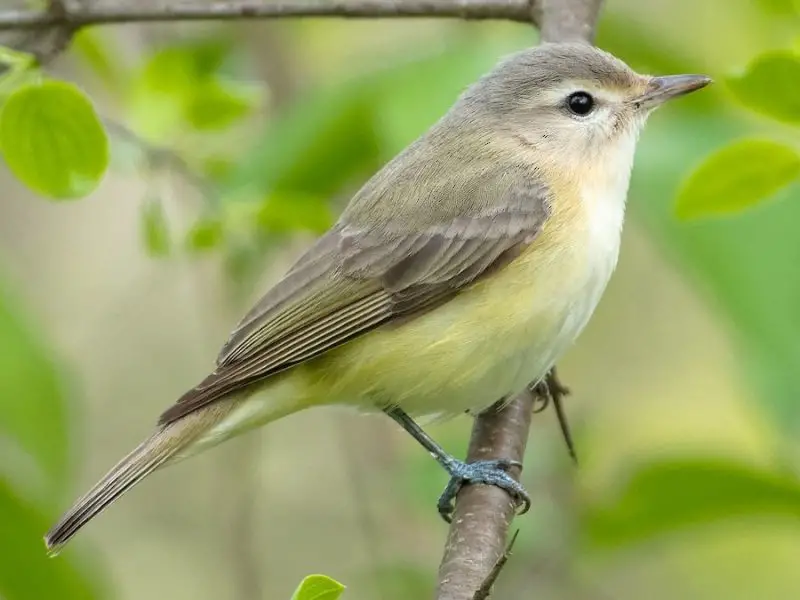
The Warbling Vireo is a modestly colored bird measuring 13 to 14 centimeters, with olive-gray upperparts and pale underparts. Its subtle plumage helps it blend into leafy trees where it spends much of its time foraging. The bird is known for its soft, melodic song, which is often described as gentle and warbling.
In New Jersey, Warbling Vireos are mainly seen during migration, moving through woodlands and forest edges. Their calm, soothing song is a pleasant sound in spring and early summer, though the birds can be somewhat secretive and hard to spot.
They primarily eat insects and spiders, searching actively among leaves and branches. While they do not commonly breed in New Jersey, their migratory visits add a peaceful musical note to the state’s spring bird chorus.
American Goldfinch
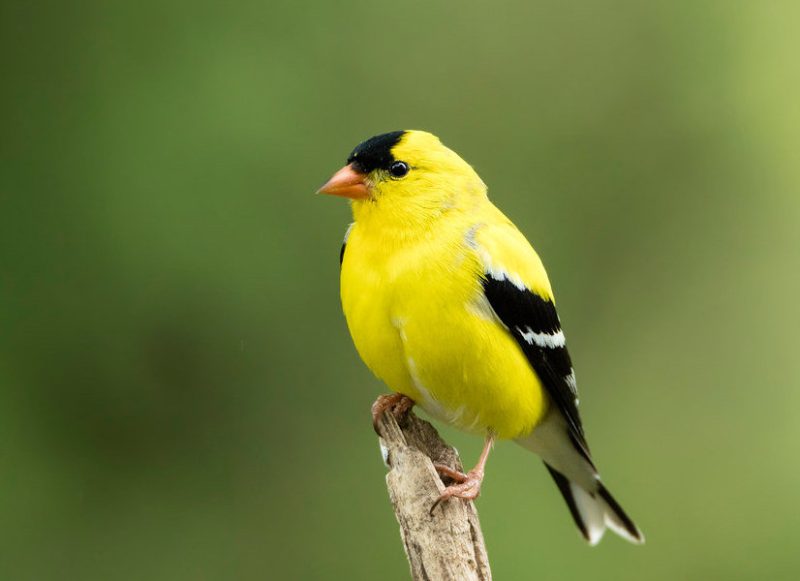
The American Goldfinch is a small, vibrant songbird measuring 11 to 14 centimeters long. In summer, males are brilliant lemon-yellow with black wings and caps, while females are a duller yellow. In winter, both sexes molt into a muted brownish tone, making them less conspicuous.
This species is widespread across New Jersey and is present year-round. It is often seen in open fields, gardens, and weedy areas, especially where thistle plants grow. Their flight is bouncy, and their call is a cheerful “per-chick-o-ree,” often heard as they move in flocks.
Goldfinches mainly eat seeds, particularly from sunflowers, thistles, and dandelions. They are common visitors to backyard feeders, especially those stocked with nyjer seed. Their seasonal color change and sweet song make them one of New Jersey’s most beloved backyard birds.
House Finch
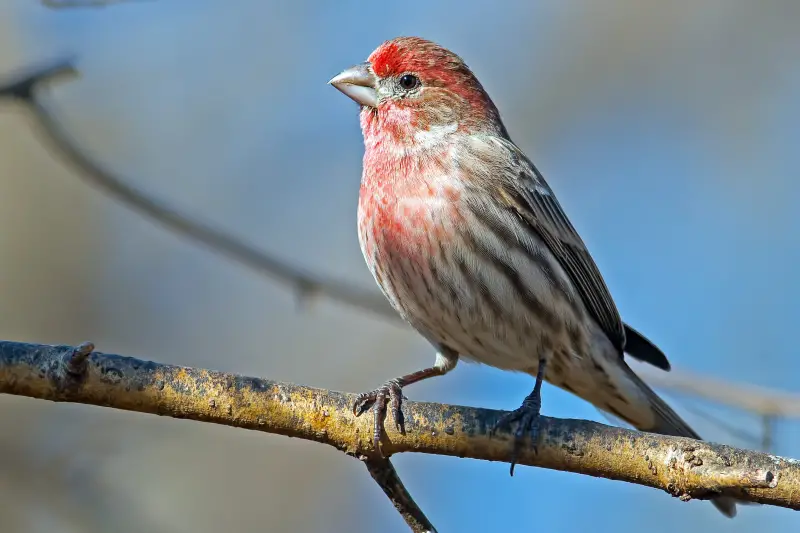
The House Finch is a medium-sized finch, measuring about 13 to 15 centimeters, with brown-streaked plumage and a reddish-orange wash on the head and upper chest of males. Females are more uniformly brown with fine streaks and lack the red coloring.
Common year-round across New Jersey, House Finches are found in urban, suburban, and rural areas, often seen perched on wires or foraging in shrubs. They sing cheerful, warbling songs and have a sharp “cheep” call frequently heard in neighborhoods and parks.
Their diet includes seeds, buds, and fruit, and they readily visit feeders with sunflower seeds. Originally from the western U.S., they have become well-established in the East, making them one of the most frequently observed feeder birds in the state.
Purple Finch
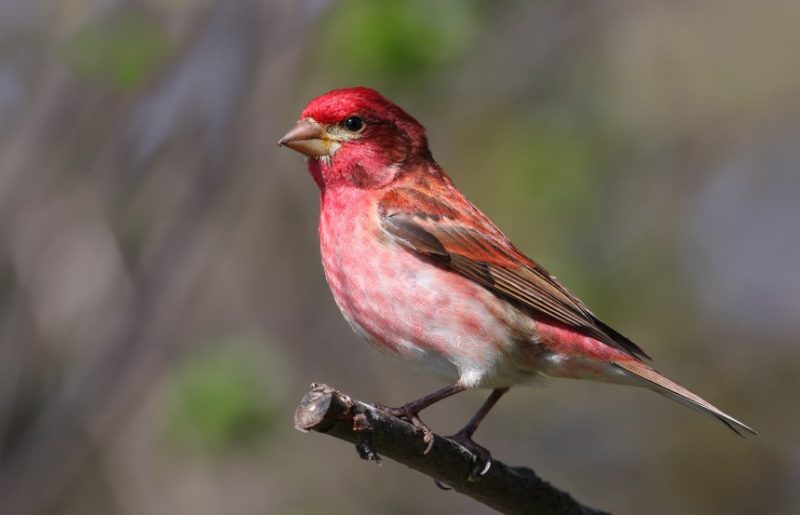
The Purple Finch is a chunky finch measuring 12 to 16 centimeters, with males showing a rich raspberry-red wash over the head and chest, blending into brown-streaked wings and back. Females are brown with bold facial markings and no red coloration.
In New Jersey, Purple Finches are mainly seen in the winter months as they migrate south from their northern breeding grounds. They frequent forests, wooded edges, and feeders during cold weather. Their rich, musical warble is softer than that of the House Finch but equally beautiful.
They feed on seeds, berries, and buds, and they often appear at feeders offering sunflower seeds. Their winter visits are irregular and can vary depending on food availability farther north, making them an exciting sighting for local birdwatchers.
Common Redpoll
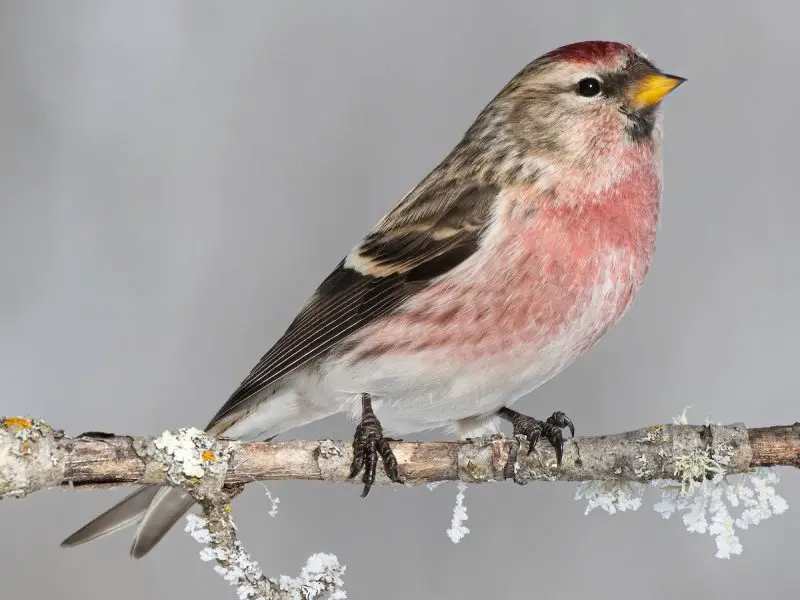
The Common Redpoll is a small finch, around 12 centimeters long, with streaked brown and white plumage and a distinctive red patch on its forehead. Males may also show a pinkish wash on the chest during the breeding season, while females lack the rosy hue.
This species appears in New Jersey mostly during irruption years, when large flocks move south due to scarce food in their Arctic breeding grounds. They are often found in weedy fields, birch stands, and backyard feeders in winter.
Common Redpolls feed primarily on seeds, especially from birch, alder, and grasses. Their energetic movements and soft “chit-chit” calls make them a delight to observe when they visit the state during colder months.
Evening Grosbeak

The Evening Grosbeak is a large finch, measuring about 16 to 22 centimeters, with males sporting bold yellow bodies, black wings with white patches, and a massive pale bill. Females are more subdued in gray with hints of yellow on the sides and neck.
This species is considered rare in New Jersey and usually appears during irregular winter irruptions. When present, they visit forested areas and feeders offering sunflower seeds, where their size and color make them impossible to miss.
Evening Grosbeaks feed on seeds, berries, and tree buds. Their strong beaks allow them to crack tough shells easily. Sightings of this species are exciting events for birders, as their visits are unpredictable and infrequent in the region.
Blue Grosbeak
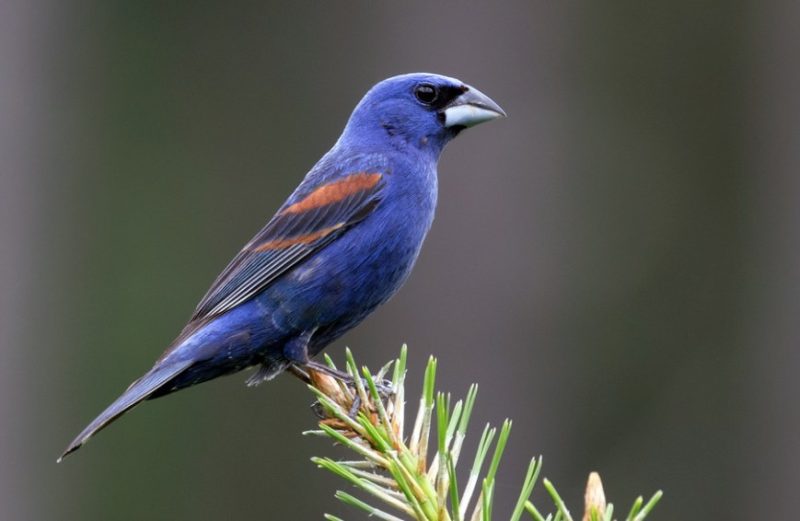
The Blue Grosbeak is a medium to large songbird, measuring 14 to 19 centimeters long. Males are deep blue with chestnut wing bars, while females are warm brown with subtle blue hints. Their thick, silver-gray beak stands out against their vivid plumage.
In New Jersey, Blue Grosbeaks are seen mainly during migration and summer in southern parts of the state. They prefer shrubby fields, open woodlands, and brushy roadsides. Their song is a sweet, warbling melody that adds charm to quiet rural areas.
Their diet includes seeds, grains, and insects, and they often forage on or near the ground. Though less common than other grosbeaks, they are a rewarding find for birders exploring open, sunny habitats during the warmer months.
Indigo Bunting

The Indigo Bunting is a small, brightly colored songbird, with adult males glowing a deep, iridescent blue all over during breeding season. Females and juveniles are plain brown with faint streaking, which helps them stay hidden in dense cover. This contrast makes the male especially eye-catching when perched in sunlight.
They are common summer residents in New Jersey, particularly in weedy fields, forest edges, and along hedgerows. Males often sing a high-pitched, paired-note song from exposed perches throughout the breeding season. Their persistent singing and brilliant color make them easy to locate despite their small size.
Indigo Buntings feed mostly on seeds, berries, and insects. They migrate at night using stars to navigate and arrive in New Jersey in late spring. Their vivid blue plumage and energetic presence bring life and color to open landscapes each summer.
Ruby-throated Hummingbird
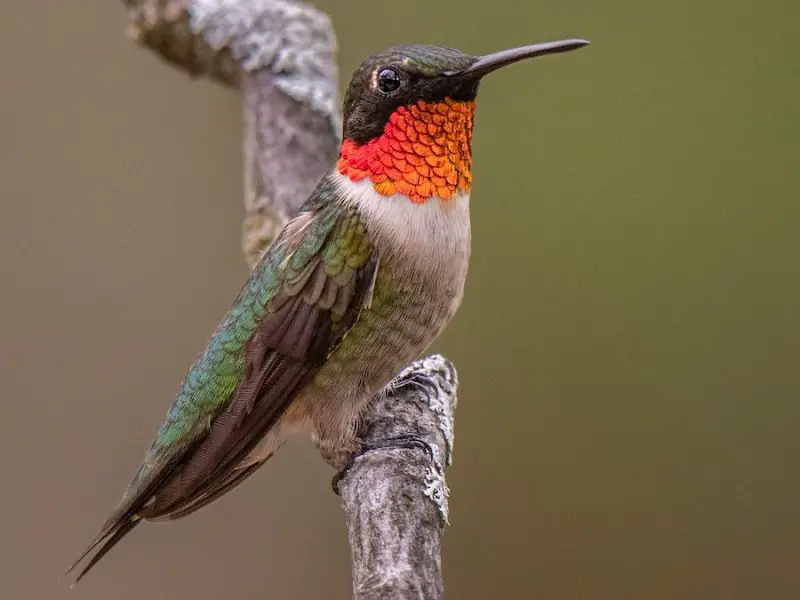
The Ruby-throated Hummingbird is the smallest bird regularly seen in New Jersey, measuring just around 8 centimeters long. Males are particularly stunning, with iridescent green plumage and a brilliant ruby-red throat that can appear black in dim light. Females lack the red throat but share the shimmering green back and white underside.
This hummingbird is a summer breeder in New Jersey, arriving in late spring after migrating across the Gulf of Mexico from Central America. It prefers gardens, wood edges, and areas rich in flowering plants. Its wings beat incredibly fast, producing a faint hum as it hovers to sip nectar.
Ruby-throated Hummingbirds feed on nectar, small insects, and spiders. They are frequent visitors to hummingbird feeders filled with sugar water. Though small, they are fiercely territorial and chase away intruders from their favorite feeding spots.
Brown Creeper
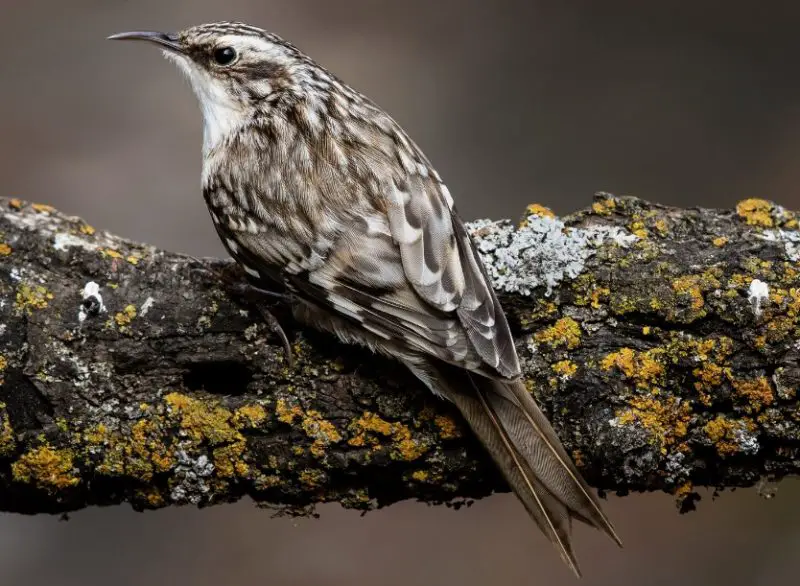
The Brown Creeper is a small, slender bird measuring 12 to 14 centimeters, well-camouflaged with mottled brown plumage that blends perfectly into tree bark. It has a stiff tail and curved bill, which it uses to probe for insects hidden in crevices.
In New Jersey, Brown Creepers are year-round residents in forested areas. They are most often seen creeping upward along tree trunks in a spiral motion, gripping the bark as they hunt. Once they reach the top, they fly down to the base of another tree and repeat the process.
Their diet consists mostly of insects, spiders, and occasionally seeds. They are quiet and inconspicuous, but their high-pitched, thin calls and unique climbing behavior help observant birders locate them in mature woodlands.
Brown Thrasher

The Brown Thrasher is a large songbird, about 24 to 28 centimeters long, with rich reddish-brown upperparts and heavily streaked underparts. It has a long, slightly curved bill and piercing yellow eyes that stand out against its plumage.
This species prefers dense thickets, hedgerows, and overgrown fields in New Jersey. Though often hidden, it is most noticeable in spring when males perch in the open and deliver long, varied songs made up of repeated phrases. Brown Thrashers are capable mimics and have one of the largest known song repertoires of any North American bird.
They feed on insects, fruits, seeds, and occasionally small vertebrates. Their foraging style involves vigorously flipping leaf litter with their bill, searching for prey. Despite their size and bold song, they can be shy and difficult to spot when not singing.
Gray Catbird
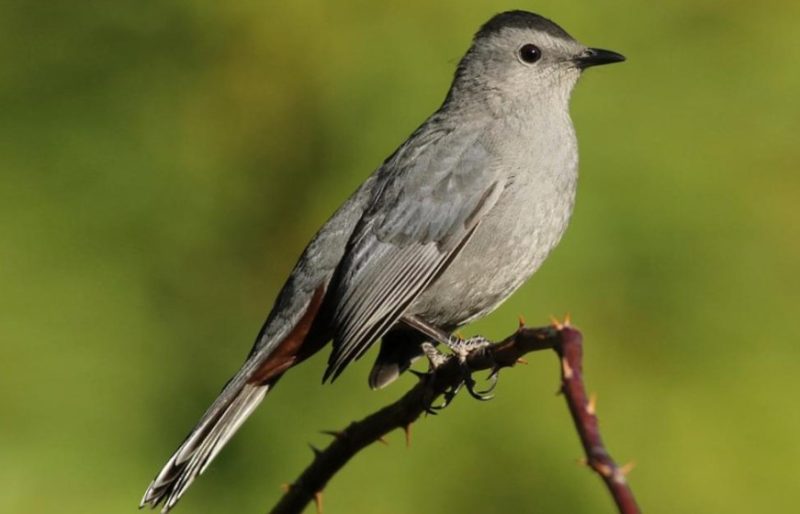
The Gray Catbird is a medium-sized bird, 20 to 23 centimeters long, with smooth slate-gray plumage, a black cap, and a dark tail. It has a slight rust-colored patch under the tail that is usually hidden unless the bird flicks its tail upward.
In New Jersey, Gray Catbirds are common summer residents, found in dense shrubs, thickets, and suburban gardens. They are named for their cat-like “mew” call, but they also mimic other birds and environmental sounds, weaving them into long, jumbled songs.
Their diet includes insects, berries, and fruit. Catbirds are active and curious, often seen hopping through low branches or singing from hidden perches. Their secretive habits and complex songs make them a rewarding find for patient birders.
Northern Mockingbird
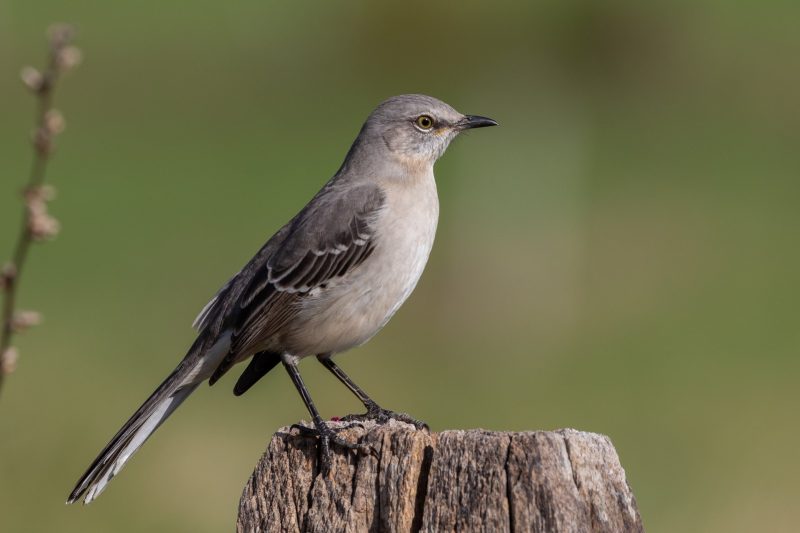
The Northern Mockingbird is a slender, medium-sized bird with gray upperparts, white underparts, and a long tail edged in white. It measures around 21 to 26 centimeters in length and has distinctive white patches on its wings visible in flight.
This bird is a year-round resident in New Jersey and is often found in open habitats, including suburbs, parks, and farmlands. Mockingbirds are famous for their vocal mimicry, often imitating other birds, mechanical noises, and even frogs in their loud, varied songs.
They feed on insects, berries, and fruits and are known to aggressively defend their territory. Northern Mockingbirds often sing at all hours, even at night during breeding season, making them one of the most vocal and conspicuous songbirds in the region.
Cedar Waxwing
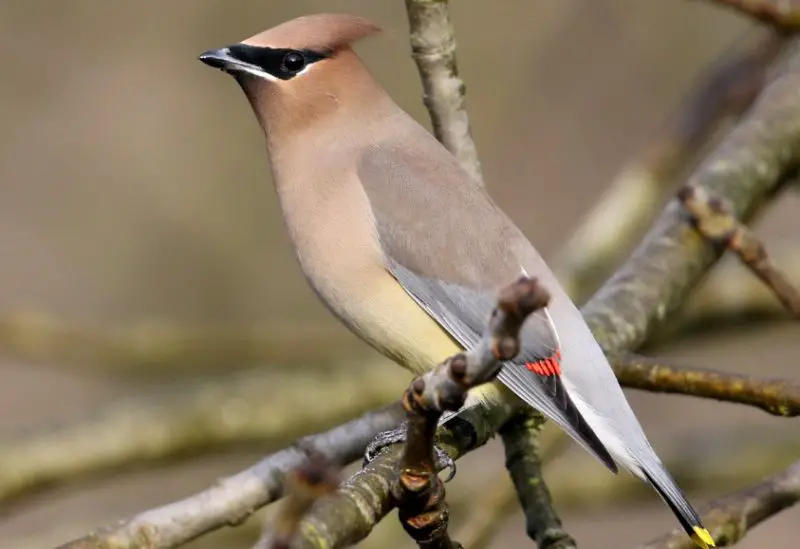
The Cedar Waxwing is a sleek, medium-sized bird with silky plumage, measuring about 16 to 18 centimeters in length. It has a soft brown head, pale yellow belly, and a black mask across its face. Its wings are gray with waxy red tips, and its tail is tipped with bright yellow.
In New Jersey, Cedar Waxwings can be seen year-round, though their movements are somewhat nomadic depending on fruit availability. They are most often spotted in flocks, perching high in trees or flying in tight groups between berry-laden shrubs.
Cedar Waxwings feed primarily on fruit, especially during winter, but also catch insects in midair during the warmer months. Their high-pitched, sibilant “see” calls are often the first clue to their presence. With their elegant appearance and social behavior, they’re a favorite among birdwatchers statewide.
FAQs about Small Birds in New Jersey
What are the most common small birds in New Jersey?
Some of the most common small birds found in New Jersey include the American Goldfinch, House Sparrow, Dark-eyed Junco, Tufted Titmouse, and Carolina Wren. These birds are regularly seen in suburban areas, backyards, parks, and forests throughout the state. Many of them visit bird feeders and are active year-round.
When is the best time to see migratory songbirds in New Jersey?
The best time to observe migratory songbirds in New Jersey is during spring (April to June) and fall (September to November). During these seasons, species like the Yellow Warbler, Cape May Warbler, and Black-throated Blue Warbler pass through the state as they migrate between breeding and wintering grounds.
What should I put in my bird feeder to attract small birds?
To attract a variety of small birds in New Jersey, offer black oil sunflower seeds, nyjer (thistle) seed, suet cakes, and millet. Different species prefer different foods—goldfinches love nyjer, chickadees go for sunflower seeds, and wrens may be drawn to suet. Providing a birdbath with clean water also helps attract more birds.
Are any of the small birds in New Jersey endangered or declining?
Yes, some small birds like the Golden-winged Warbler have experienced significant population declines due to habitat loss and hybridization. While not all are officially endangered, conservationists closely monitor these species. Supporting native plants and preserving natural habitats can help protect these vulnerable birds.
How can I identify small birds by their song?
Learning bird songs takes practice, but many small birds have distinct vocalizations. For example, the Chipping Sparrow has a sharp “chip… chip…” call, while the Northern Mockingbird mimics many other species. Apps like Merlin Bird ID or websites like the Cornell Lab of Ornithology’s All About Birds can help with identification.
Do small birds stay in New Jersey during the winter?
Yes, many small birds remain in New Jersey year-round, including the Black-capped Chickadee, Tufted Titmouse, and House Finch. Others, such as the American Goldfinch and White-throated Sparrow, may stay through the winter in large numbers. Providing food and shelter during colder months can help them survive the season.
Where are the best places for birdwatching in New Jersey?
New Jersey offers a wide range of birdwatching spots, including Cape May, the Great Swamp National Wildlife Refuge, Duke Farms, and Sandy Hook. These locations are hotspots during migration and support diverse bird populations year-round, making them ideal for spotting both common and rare small birds.

